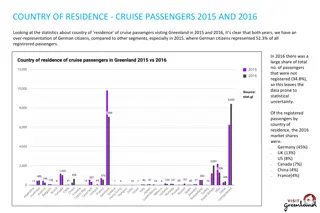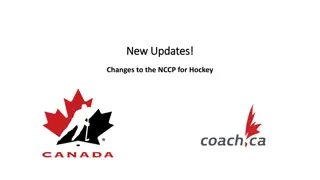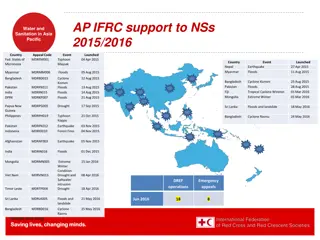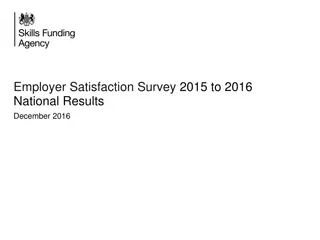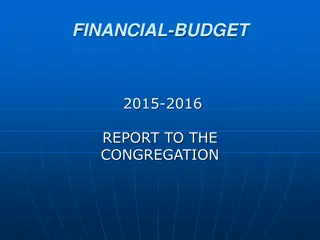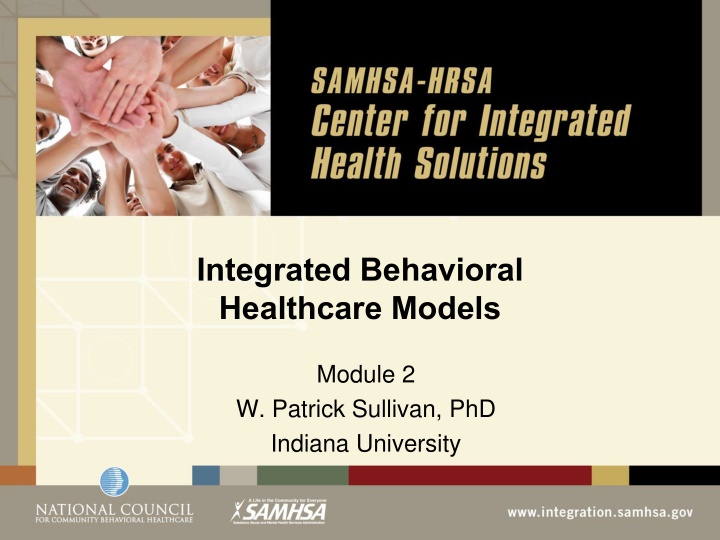
Integrated Behavioral Healthcare Models and Social Policy Impacts
Explore the integration of behavioral healthcare models with social policy impacts, addressing mental health, mental illness, addiction, and how definitions of problems influence social programs and resource allocation. Delve into the complexities of defining mental health, mental illness, and addiction in the context of social constructs and societal norms.
Uploaded on | 0 Views
Download Presentation

Please find below an Image/Link to download the presentation.
The content on the website is provided AS IS for your information and personal use only. It may not be sold, licensed, or shared on other websites without obtaining consent from the author. If you encounter any issues during the download, it is possible that the publisher has removed the file from their server.
You are allowed to download the files provided on this website for personal or commercial use, subject to the condition that they are used lawfully. All files are the property of their respective owners.
The content on the website is provided AS IS for your information and personal use only. It may not be sold, licensed, or shared on other websites without obtaining consent from the author.
E N D
Presentation Transcript
Integrated Behavioral Healthcare Models Module 2 W. Patrick Sullivan, PhD Indiana University
Objectives of Module 1. Demonstrate how various definitions of a problem or need impact social policy formulation, social program design, and the allocation of social resources 2. Introduce various models central to integrated care and demonstrate how these models impact how one views mental health, physical health, mental illness, physical illness, and addictions 3. Consider how each module contributes to the effort to integrate care and produce positive outcomes for individuals and society
Defining the Problem How a problem is defined is a crucial social policy decision when problems are defined broadly, based on the current assumptions that undergird our system, the scope of the problem always outstrips the resources dedicated to deal with the problem. Therefore, social policy centers on the allocation of scarce resources or is described as Distributive Justice. 1
Social Policy Social policies ultimately reflect one of myriad ways one can understand the causes and consequences of a defined social problem and one of myriad ways this problem can be addressed. Social policies can define target populations, entitlement rules, forms of benefit, and directly or indirectly impact the design of social programs, the selection of services to be delivered, and how those services are delivered.
Mental Health or Mental Illness What are the implications for policy focused in mental health? Key issues: prevention, resilience, enrichment, opportunities, capabilities What are the implications for policy focused on mental illness? Key issues: treatment, locus of care, cost
What is Mental Illness? Is it real or a myth is it language a social construct - a matter of social control? If real where is the line between health and illness? What do terms like schizophrenia, bi-polar disorder, or borderline personality really mean? Can we truly assess them with the tools at our disposal?
What is Addiction? Is addiction a disease? Is it a personal problem? Is it influenced by social forces? Is it defined by social norms?
How Policy Makers Distribute Resources They make decisions based on: Knowledge of need and sense of effectiveness of service options Perceptions of resource scarcity Political ideology of individual decision makers Perception of recipients responsibility for problems that require service2
Consider this Mental health problems range from problems in living to those considered severe and persistent. While those who have less severe illnesses may recover at a greater rate than those facing greater challenges, the latter have far greater needs and are the most costly to serve. How should scarce resources be allocated and why?
Or.. Consider those challenged by addictions. How do various models of addiction and even public perception of this problem impact resource allocation and the nature of the services that are delivered?
Who Is Deserving of Resources Those who advocated for populations who are commonly viewed as responsible for their own plight will likely face stiff resistance to their cause. Responsibility can be assessed on the basis of: Notions of internal versus external locus of control Whether the causal event was viewed controllable
Mental Health & Mental Illness Mental health is a state of successful performance of mental function, resulting in productive activities, fulfilling relationships with other people, and the ability to adapt to change and to cope with adversity -- but what constitutes health is rooted in value judgments and impacted by culture. Mental illness is marked alterations in thinking, mood and behavior that contributes to distress, impaired functioning, or heightened risk of death, pain, disability, or loss of freedom.3
Integrated Behavioral Health Models The various models described reflect a range of lenses one can use to view mental health, physical health, mental illness, physical illness, and addictions. Each of theses models inform health care policy, and ultimately the nature of the services commonly offered in behavioral health, mental health, and in integrated care.
As you review these models consider how the can contribute to the integration of physical and behavioral health care. In addition, given the interest in recovery in both mental health and addiction consider how each model can help and/or hinder this goal.
The Medical Model The primary focus is on illness and disease According to Ludwig (1975) mental illness is defined as any debilitating, cognitive-affective behavior disorder due primarily to known, suggestive, or presumed biological brain dysfunction, either biochemical or neurophysiological in nature 4(p.603)
Medical Model Intervention Key professional responsibilities include: 1) Differential diagnosis 2) Diagnosis made on basis of specific symptoms and signs, laboratory tests, and knowledge of the natural history and prognosis of the condition. 5 3) Choice of therapeutic environment 4) Selection of therapy (including medication)
Medical Model Approach Scientific or based on the scientific method Objective Reductionist - thus only those conditions that met the definition of mental illness were within the purview of psychiatry the whole person including other contextual factors that impact the nature of the individual s situation are thus largely ignored.
Role of Professional in Medical Model a) Control over the process of care rests with the professional b) The professional possesses the most relevant knowledge and expertise c) The use of specialized technical language and nomenclature is omnipresent d) As a result the patient role is largely passive
Arguments for Medical Model a) Great strides been made in the understanding of mental illness and the brain A disease or medical perspective can reduce stigma for those identified as suffering from mental illness and addictions by removing blame Has produced noteworthy advancement in important areas of care in particular, pharmacology Provides a framework to support evidence-based practice b) c) d)
Arguments Against the Medical Model Exclusive focus on illness and disease can also lead to stigma and labeling Individual strengths and capabilities which can abet recovery are minimized The contribution of family, social, and environmental issues in the disease and health process are largely ignored The importance of the recipient s expertise and knowledge about their life and situation is minimalized The recipient plays a passive role in their care process Reflects mind/body dualism The imprecision of health/illness distinctions and changing nature of social norms and standards largely ignored
The Biopsychosocial Model Disease is not solely accounted for by deviations from the norm of measurable biological or somatic variables To provide a basis for understanding the determinants of disease and arriving at rational treatments and patterns of health care, a medical model must also take into account the patient; the social context in which he (sic) lives; and the complementary system devised by society to deal with the disruptive effects of illness. 6 (p. 132)
The Bio-psycho-social Approach Affirms the role of the recipient in the helping encounter, and acknowledged their key role in understanding and interpreting their experience Underscores the importance of the professional relationship beyond technical expertise and acumen Underscores the role of social context and conditions as determinants of disease and as sources of support and healing Acknowledges that the boundary between health and disease is not well defined and is socially defined particularly in behavioral health Informed by General Systems Theory which views the person as a part of a self-regulating, integrated system
Prevention and Wellness Model7 Wellness refers to the degree to which one feels positive and enthusiastic about oneself and life, whereas illness refers to the presence of disease Health care reform: refers to efforts focused on illness, such as treatment of disease and related rehabilitation efforts Health reform: efforts focused on health, such as health promotion and the development of positive well- being
Prevention and Wellness Model Rationale Mental health is frequently intertwined with physical health and social conditions. Negative (health determinants) are disproportionately distributed among minority populations Well-being serves as a protective influence Different interventions and approaches are needed for different subpopulations Recovery is a process that bridges illness and wellness A focus on wellness and well-being is important to health reform including mental health8
Prevention and Wellness Approach Takes a public health approach to health care: We must alter the status quo by changing from illness- oriented medical care to prevention; harmful community settings to health environments; and health-eroding policies to one that supports wellness 9(p. 5) Primary prevention consists of those scientific practices aimed at simultaneously preventing predictable problems in individuals or populations at risk; protecting or maintaining current strengths, competency, or levels of health and healthy functioning; and promoting desired goals and enhancing human potential10 (p. 1895).
Strategies for Prevention and Wellness Population level Monitor the health status of groups of people Track health risks Determine sources of disease and transmission Assess the impact of public policies Engage in population planning Help improve physical features of communities11
Prevention and Wellness Activities a) Disease management b) Harm reduction c) Medication management d) Self-care initiatives
Chronic Care Model12 Due to the aging of the population and greater longevity, more people live with chronic health conditions than at any time. Among those challenged by behavioral health conditions some key chronic conditions have earlier onset, and because of lifestyle, high risk environments and the lack of access to treatment mortality rates are extreme Common issues include diabetes, asthma, hypertension The term serious and persistent mental illness suggest a course of long duration, with a non-linear course of recovery Likewise in treatment for addictions the term in recovery is rarely viewed as an end state but rather a constant state. Accordingly, substance use can be viewed as a chronic condition regardless of the individuals current pattern of use
Chronic Care Model Rationale While the health care system is largely designed to address acute and episodic conditions, it is argued that health systems should also be designed to match the needs of those facing chronic conditions. The cost of caring for those with chronic conditions can be high given the volume of services needed, and in some cases the disproportionate use of intensive and expensive care
The Chronic Care Model Approach Self management support Clients have a central role in managing their care, which includes Collaborative problem definition, Goal setting and planning Self-management training and support services and Active follow-up Decision support The integration of evidence-based guidelines into daily practice Delivery System Design Use of practice teams. Long-term clients remain in primary care or with a behavioral health team in all cases the quest is to establish a single source of care Clinical information Systems Manage populations the use of alerts and flags to encourage follow-up, other important management tools. Client registries may be of use here Community linkage and polices noted by the development of partnerships, formal and informal, with organizations, program, people and resources. Vital to health promotion and prevention as well as to quality care
The Recovery Model Recovery refers to the process in which people are able to live, work, learn, and participate fully in their communities. For some individuals, recovery is the ability to live a fulfilling and productive life despite a disability. For others, recovery implies the reduction or complete remission of symptoms. Science has shown that having hope plays an integral role in an individual s recovery.13
SAMHSA Working Definition of Recovery A process of change through which individuals improve their health and wellness, live a self-directed life, and strive to reach their full potential. SAMHSA has defined the following as essential elements for living a life of recovery: Health : overcoming or managing one s disease(s) as well as living in a physically and emotionally healthy way; Home: a stable and safe place to live; Purpose: meaningful daily activities, such as a job, school, volunteerism, family caretaking, or creative endeavors, and the independence, income and resources to participate in society; and Community : relationships and social networks that provide support, friendship, love, and hope.
The Role of the Professional in Recovery Model Use hope-inducing behaviors and practices Believe individuals can and do recover Amplify client s voices Engage in goal-directed treatment Facilitate individual choice and self- determination Include family and significant others (with permission) Expect life beyond the mental health system - community and social inclusion Emphasize natural community supports Recommend peer support networks and services
The Recovery Approach 1. The focus is on individual strengths not pathology 2. The relationship is primary and essential 3. Interventions based on client self-determination 4. Community is an oasis of resources, not an obstacle 5. Aggressive outreach is the preferred mode of intervention 6. People suffering from serious and persistent mental illnesses can learn grow and change
Recovery and Wellness Recovery in mental health also emphasizes health and disease management in areas such as recognizing and controlling symptoms, the relationship between healthy behaviors and mental health, the importance of social support, and medication management. Integrated care can help by attending to the common health problems that accompany serious mental illness.
Recovery Model for Substance Use Disorders14 There are many models of recovery in the field of addiction treatment treatment which focus on following themes 1. Managing symptoms of the disorder 2. The need for personal control or choice 3. Hope 4. Sense of Purpose 5. Sense of achievement 6. The presence of at least one person (support)
SAMHSAs Center for Substance Abuse Treatment GuidingPrinciplesof Recovery SAMHSA defined Componentsof Recovery 1. There are many pathways to recovery. 1. Self-direction 2. Recovery is self-directed and empowering. 2. Individualized and person-centered 3. Recovery involves a personal recognition of 3. Empowerment the need for change and transformation. 4. Recovery is holistic. 4. Holistic 5. Non-linear 5. Recovery has cultural dimensions. 6. Strengths-based 6. Recovery exists on a continuum of 7. Peer support improved health and wellness. 7. Recovery is supported by peers and allies. 8. Respect 9. Responsibility 8. Recovery emerges from hope and gratitude. 10. Hope 9. Recovery involves a process of healing and self- redefinition. 10.Recovery involves addressing discrimination and transcending shame and stigma. 11. Recovery involves (re)joining and (re)building a life in the community. 12. Recovery is a reality. It can, will, and does happen.
Similarities between the two approaches Mental Health Componentsof Recovery Addiction Guiding Principlesof Recovery 1. There are many pathways to recovery. 1. Self-direction 2. Recovery is self-directed and empowering. 2. Individualized and person-centered 3. Recovery involves a personal recognition of 3. Empowerment the need for change and transformation. 4. Recovery is holistic. 4. Holistic 5. Non-linear 5. Recovery has cultural dimensions. 6. Strengths-based 6. Recovery exists on a continuum of 7. Peer support improved health and wellness. 7. Recovery is supported by peers and allies. 8. Respect 9. Responsibility 8. Recovery emerges from hope and gratitude. 10. Hope 9. Recovery involves a process of healing and self- redefinition. 10. Recovery involves addressing discrimination and transcending shame and stigma. 11. Recovery involves (re)joining and (re)building a life in the community. 12. Recovery is a reality. It can, will, and does happen.
Recovery Model for Addiction Treatment Approach15 Accordingly, the stages and tasks of addiction care provide a platform for integrated care 1. Mirrors strategies for other chronic disorders in addiction recovery lacks an endpoint 2. Effective treatment systems offer a continuum of care 1. Pretreatment engagement and motivation strategies 2. In-treatment retention and support strategies acquisition of skills 3. Post-treatment recovery - extended follow-up 3. Continuing care use of community support, use of technology including telephone monitoring, computer based assessment, telemedicine
Why Social Workers Understand IBH By adopting a biopsychosocial spiritual frameworks social work naturally takes a systems or ecological view of human conditions Social work respect for individual uniqueness and dignity and well-matched for strengths and recovery-based practice and to work collaboratively with recipients of care By virtue of a tradition of drawing form systems and ecological models of human behavior social workers understand the importance of social context in understanding illness and health With a broad view of resources social work routinely looks to family and peers as sources of support and to naturally occurring social resources as important aspects of goals and care planning By virtue of understanding systems, resources, and by embracing a strengths and recovery principles social workers can work effectively in health care systems that must maximize fiscal and human resources, and routinely consider issues of equity, effectiveness and efficiency when managing care
Conclusion Each of the models above helps to understand the challenges people face Integrated care is designed to deal with complex situations and focus on the whole person Rarely do effective services draw from just one of these models, particularly when making a commitment to person-centered care Social Work is ideally positioned to assume a key role in the effort to integrate health care
References 1. Rawls, J. (1971). A Theory of Justice. Cambridge, MA: Belknap Press of Harvard University Press. 2. Corrigan, P., & Watson, A. (2003). Factors that explain how policy makers distribute resources to mental health services. Psychiatric Services, 54(4), 501-507. 3. U. S. Department of Health and Human Services. (1999). The Reports of the Surgeon General. Retrieved from http://profiles.nlm.nih.gov/ps/retrieve/ResourceMetadata/NNBBHS 4. Ludwig, A. (1975). The Psychiatrist as Physician JAMA, 234(6), 603-604. 5. Ludwig, A. (1975). The Psychiatrist as Physician JAMA, 234(6), 603-604. 6. Engel, GL. (1977). The need for a new medical model: A challenge for biomedicine. Science, 196, 4286, 129-136. 7. Manderscheid, R., Ryff, C., Freeman, E., McKnight-Elly, L., Dhingra, S., & Strine, T. (2010). Evolving definitions of mental illness and wellness. Preventing Chronic Disease, 7(1), 1-6. 8. Manderscheid, R., Ryff, C., Freeman, E., McKnight-Elly, L., Dhingra, S., & Strine, T. (2010). Evolving definitions of mental illness and wellness. Preventing Chronic Disease, 7(1), 1-6. 9. French, M. (2009, April) Shifting the course our nation s health: Prevention and wellness as National policy. Washington D.C.: American Public Health Association. 10. Bloom, M. (1995). Primary prevention overview. In RL Edwards, ed., Encyclopedia of Social Work, 19thed., 1:1895-1905. Washington DC: National Assocation of Social Workers. 11. French, M. (2009, April) Shifting the course our nation s health: Prevention and wellness as National policy. Washington D.C.: American Public Health Association. 12. Institute of Medicine of the National Academices. (2012, July 10). The mental health and substance use workforce for older adults: In whose hands? Consensus Report, Board on Health Care Services. 13. President s New Freedom Commission on Mental Health. (2003, July). Achieving the promise: Transforming mental health care in America. Rockville, MD. 14. Van Wormer, K., & Davis, D. (2008). Addictions treatment: A strengths perspective, 2ndEd. Belmont, CA: Thomson Higher Education. 15. el-Guebaly, N. (2012). The meanings of recovery from addiction. Journal of Addiction Medicine, 6(1), 1-9

